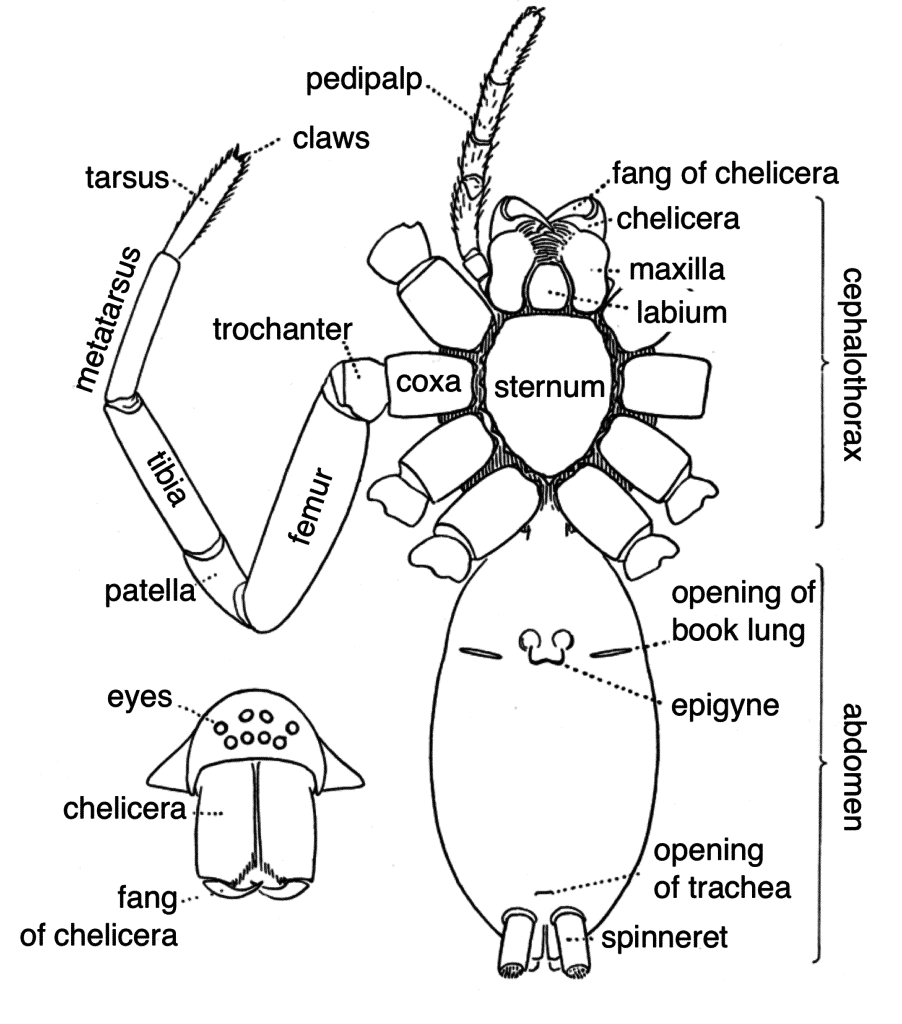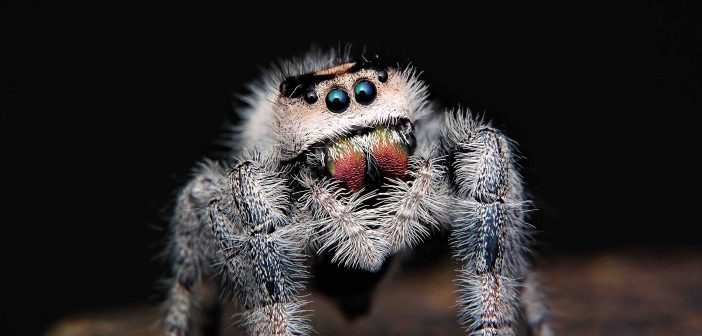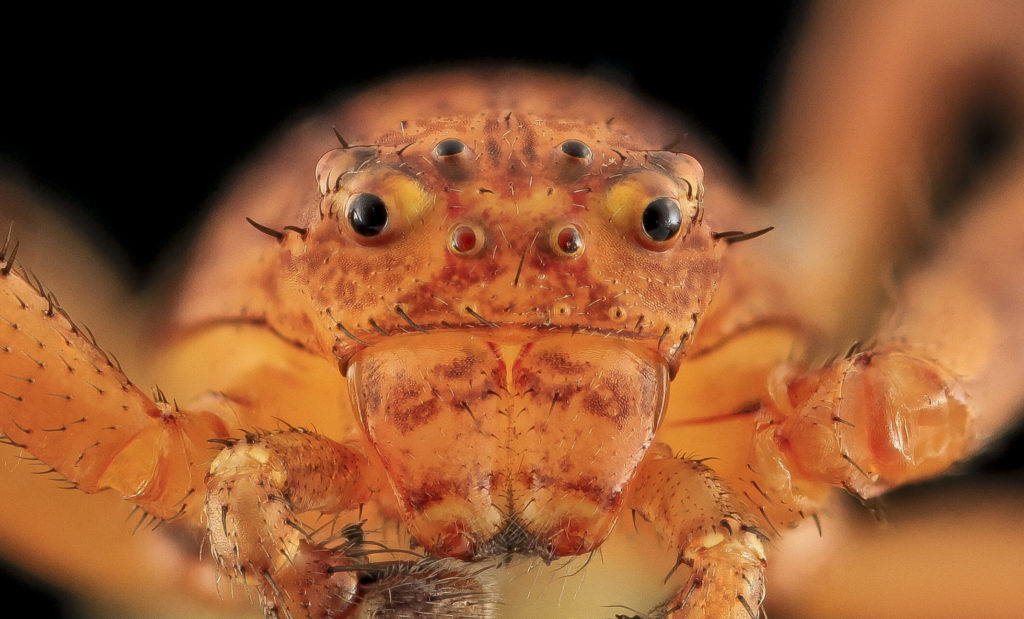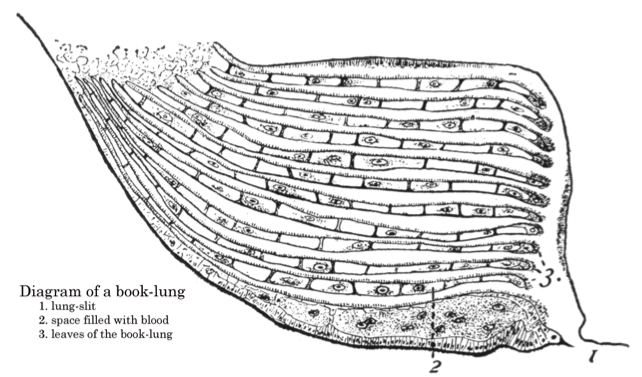Part 1: Beneficial, Background • Why spiders aren’t insects • Cephalothorax, Legs • Brain, Mouthparts, Fangs • Senses • Opisthosoma, Digestive, Alimentary, Circulatory, Respiratory Systems Part 2: Silk, Spinnerets • Webs • Reproduction • Lifespan, Foods, Predators
Introduction
Spiders surround us: A 2017 study3 that examined reports of spider populations in different habitats around the world found that there are 131 spiders per 3.3 square feet (1 sq m) on average. “Favorable” conditions could have up to 1,000 per square meter! Yet—think about it—how many spiders have bitten you? One or two? Several? According to experts, probably none, as spiders rarely bite humans but are typically blamed for bites delivered by other insects, such as flies, ants, fleas, mosquitoes, some beetle and true bug species, and others. They simply aren’t interested in humans, and most can’t even penetrate human skin.
Spiders are beneficial
Spiders are predators always on the hunt for tiny critters, and that’s a massive benefit to us: A single spider eats about 2,000 insects a year, and it’s estimated that around the world, spiders consume 400–800 million tons annually! Norman Platnick, an arachnologist who used to study spiders at New York’s American Museum of Natural History, said, “If spiders disappeared, we would face famine. Without [them]all of our crops would be consumed by those pests.”4
Spiders benefit other wildlife, too, because they’re prey for parasitic wasps, birds, lizards, frogs, toads, and small mammals. They’re eaten by other spiders, too.
Background
Spiders are in the class Arachnida (a word derived from the Greek arakhne, meaning spider), which also includes mites, ticks, harvestmen, and scorpions. Their order is Araneae. There are at least 48,200 species in the world, inhabiting every continent except Antarctica and nearly every kind of terrestrial habitat. About 3,400 species inhabit North America.
Origin
Spiders have been around for eons, but there are few fossil records because their soft bodies easily deteriorate. Those that exist are usually preserved in amber. (Spiders in the genus Nephila are the longest-lived modern spiders, they’ve existed since the Middle Jurassic, 165 million years ago.) The world’s tiniest spider today is probably the male Patu digua, only 0.02 inches (0.37 mm), about the size of a pinhead. The largest spider is the Goliath Birdeater Tarantula, Theraphosa blondi, which has a leg span of up to 10 inches (25.4 cm) and may weigh more than 6 ounces (170 g).
Not insects
It’s commonly thought that spiders are insects, but the two are classified separately. Several features distinguish them apart. The most noticeable are:
- Spiders have two body sections; insects have three.
- Spiders have eight legs; insects have six.
- Spiders don’t have antennae; insects do.
Spiders come in different shapes, sizes, and colors–short, long, round, oblong, thin, fat, spiky, hairy, smooth, bright, dull, and more. Below are just a handful of their wide variety and, in some cases, beauty:
Cephalothorax (front body section)
Spiders have two body segments: Cephalothorax and Opisthosoma, both covered by an exoskeleton.

Underside of spider anatomy with cutout showing topside of head (James Henry Emerton, “The Common Spiders of the United States,” 1902, as derived by Peter Coxhead / Wiki; CC BY-SA 4.0)
The cephalothorax, or prosoma, contains the brain, central nervous system, mouth, eyes, esophagus, part of the digestive system, and venom glands. It’s a fusion of the head and thorax and is protected by hard “shells” on the top (carapace) and the underside (sternum), which are made of protein and chitin. Chitin is a polysaccharide that produces a tough material called cuticle. Underlying the cuticle is a layer of epithelial cells containing granules of pigment, which give spiders their colors. The spider’s four pairs of legs are attached to the prosoma.
Legs
Spiders have eight legs with seven segments: the coxa, trochanter, femur, patella, tibia, metatarsus, and, at the end, the tarsus. Each leg has claws at the tip—web-spinning spiders have three, all others have two—with thousands of tiny, flexible hairs covering them. Each hair creates a contact point between a spider and the surface it’s standing on. Through a process called dynamic attachment, they can quickly adhere and loosen, allowing the spider to walk horizontally, vertically, and across a ceiling. Some surfaces, like glass and porcelain, can defeat them, however, which is why you may sometimes find a spider trapped in your bathtub or sink.
Should a spider lose a leg, it can still walk and cling to surfaces without a problem. If it’s a young one with at least one more molt to go, it will regenerate its leg. (Spiders’ legs are, by the way, the feature that people find most disturbing, along with their unpredictable movements.)
Brain and intelligence
The brain takes up a disproportionately large area of the spider’s body—80 percent or more in some species—making them remarkably smart. Who would have expected that? Research is showing their intelligence is on a par with that of larger animals. For example, jumping spiders in the genus Portia plot intricate routes to reach and ambush their prey, and orb-weaver spiders (family Araneidae) can count: They keep track of how many silk-wrapped prey they’ve stored in their web (more about webs later). Remove one or more, and the spider will search for them in proportion to the number taken.6
Mouth and fangs
You wouldn’t want to be prey in the grip of a spider. It uses two fang-tipped appendages, called chelicerae, which have finely serrated inner edges, to catch and hold prey while venom is injected into it. Venom (only spiders in the small family Uloboridae lack it) is a mixture of chemicals produced by the venom gland. One of them is a neurotoxin, which subdues or kills the captured prey, and another is a cytotoxin, which liquifies the tissues of its body. It can also be sawed up by the chelicerae.

The fangs of the Black Wishbone Spider, Aname atra, are positioned vertically (Steven Clark / Wiki; CC BY-SA 2.5)
Fangs operate in one of two ways. Those of spiders in the infraorder Mygalomorphae point down and open and close vertically, in parallel. Spiders in the infraorder Araneomorphae have fangs that move transversely in a pincer-type action.

Spiders in the infraorder Araneomorphae have fangs that move transversely (Liji Jinaraj / Flickr) (CC BY-SA 2.0)
Pedipalps
Pedipalps are two segmented appendages at the front of the prosoma. They’re located between the chelicerae and the first pair of legs. They’re usually shorter than the legs (although they can be easily mistaken for them). Spiders use them like arms to hold prey. Males also use them during mating. You can often identify an adult male because he’ll have bulbous tips on his pedipalps.
Eyes
Located above the mouthparts are the eyes, usually four pairs, positioned symmetrically. Like those of a human, spider eyes have a curved cornea and a lens, but the focus is fixed, so their vision isn’t as good. It’s believed that at least some species have color vision. A few families have only three pairs, and some primitive groups, such as cave spiders that live in the dark, have anywhere from two to eight pairs and very little vision. One cave species, Sinopoda scurion, has lost its eyes altogether. Different families have different eye patterns—dozens of them—and they’re pretty interesting. Notice the extreme difference between the two spiders below:
A spider’s “primary” pair of eyes are always at the front and have the best vision. The others, called secondary eyes, are less acute but no less important: they provide periphery views. The secondary eyes have a tapetum, which is a light-reflecting layer, so here’s a fun activity for you and your kids: on a dark summer night, use a strong flashlight to look closely at shrubs and flowers; you’ll see these tiny eyes, even though you can’t discern any other part of a spider’s body.
Hearing, taste, smell
Spiders don’t have ears, and they don’t hear in the way humans do. Instead, they hear with hairs on their body, which are sensitive to touch and vibration. Each is like a single, independent ear. The most sensitive are long hairs on the legs called trichobothria. They can feel air movement down to one ten-billionth of a meter (the width of an atom)!
Hairs are also the medium through which spiders taste and smell—they’re connected to sensory organs that detect the chemical composition of what they touch. “Hmm, is that a tasty moth or the gorgeous spider of my dreams?” Spiders don’t take action unless they detect prey or a mate. Experts think they may also use hairs on their pedipalps to taste prey.
And, hairs play a role in locomotion: Each leg has claws at the tip—web-spinning spiders have three, all others have two—with thousands of tiny, flexible hairs covering them. Each hair creates a contact point between a spider and the surface it’s standing on. Through a process called dynamic attachment, they can quickly adhere and loosen, allowing the spider to walk horizontally, vertically, and across a ceiling. As National Geographic puts it, they work like a “Post-It Note” that sticks and easily unsticks. (Some surfaces, like glass and porcelain, can defeat them, though, which is why you may sometimes find a spider trapped in your bathtub or sink.)
Communication
Pheromones are one of the means through which spiders (generally just the females) communicate with males. Both sexes also use vibrations and touch. The male wolf spider, Gladicosa gulosa, even creates airborne sounds by vibrating leaves or other surrounding structures and also “purrs” to females. Listen to the wolf spider. Male Black Widow Spiders, Latrodectus Hesperus, and Hobo Spiders, Eratigena agrestis, vibrate their abdomen on the threads of females’ webs to announce their presence.
Opisthosoma (abdomen)
The opisthosoma, or abdomen, is the back segment of the spider. A thin, waist-like tube called the pedicel connects it to the front. The foregut and a bundle of nerve fibers from the brain pass through it. The pedicel is flexible, which allows the abdomen to move in all directions as spiders make their webs.
The abdomen is soft and pliable, which allows it to expand when filled with lots of food or when holding eggs. It contains the digestive, alimentary, circulatory, respiratory organs, reproductive organs, and silk glands. At the end are four to six spinnerets and the anus.

Internal anatomy of a female two-lunged spider (John Henry Comstock, The Spider Book, 1912, as derived by Kaldari et al / Wiki; CC BY 3.0)
Eating
Spiders are opportunistic eaters. They may have to go for long periods without eating if food is scarce. So they gorge on food, usually insects, when they can. Those that actively hunt for prey probably eat more regularly than spiders that lay in wait on their webs or flowers.
They use their chelicerae to grasp and hold prey while injecting venom. To immobilize and carry it, some spiders wrap it in silk, turning it over and over to cover it completely. Sometimes, the unfortunate victim is stored away to eat later. A spider’s mouth is shaped like a short, tiny drinking straw and sucks rather than chews.
Digestive system
The digestive system begins at the mouth. All but a few spiders are carnivores, and the animals they eat must somehow go through the spider’s esophagus, which is very narrow. To accomplish that, most of them reduce their prey to a liquid by covering it with caustic digestive enzymes. A sort of pump, called the “sucking stomach,” located in the prosoma, pushes the enzymes forward and out through ducts in the chelicerae onto the prey. After waiting a bit, the spider can then suck food that’s been liquified through its esophagus. It’ll do this repeatedly until everything but tiny bits of undigestible material is consumed. (Tiny hairs surrounding the spider’s mouth are designed to filter out any non-liquid particles, but some minuscule solids do still get through.)
The liquid flows into pouches, called caeca, which range through the spider’s body and can nearly fill the abdomen to bursting in a well-fed spider. A really full spider may even have caeca filling the top part of its legs. Such a spider can go a long time without eating.
Alimentary system
Spiders don’t produce urine, but they do produce uric acid from excretory organs called Malpighian tubules that are analogous to human kidneys. The uric acid combines with solid waste in a pouch called the stercoral pocket, located in the hindgut, then moves out through the anus. Look around on a spider’s web, and you’ll see tiny white or colored spots—spider poo.
Circulatory system
Like insects, spiders have an open circulatory system. The heart, a tube with small holes in it, pumps blood (hemolymph) through arteries that empty directly into the body cavity, where it surrounds all the organs and tissues to provide nutrients to them. Spiders have no veins. The blood contains hemocyanin, a copper-based protein that causes it to turn blue-green when oxygenated.)
Lungs and breathing
Spiders don’t actively breathe. As their heart beats, air enters, and carbon dioxide is removed passively. There are two kinds of breathing systems among spiders: Some have a network of tracheae that connect to an outside opening (spiracle) in the spider’s body, located near the spinnerets. But most spiders have a “book lung.”
Surrounded by blood, the book lung is thin and hollow and has plates stacked like pages in a book. Connected to it is a slit-like opening in the spider’s underside, where oxygen enters and carbon dioxide exits. Some spiders have two pairs of book lungs. Others, such as orb-weavers and wolf spiders, have one book lung and trachea. There are still others that only have trachea.
On Page 2: spinnerets, silk, webs, reproduction, spiderlings, lifespan, food, predators, defenses
| 1 A nursery rhyme set to song. First published in 1920, it’s of unknown origin. |
| 2 A famous catchphrase of Rodney Dangerfield (1921-2004) who was known for his self-deprecating humor. |
| 3 Nyffeler, M., Birkhofer, K. “An estimated 400–800 million tons of prey are annually killed by the global spider community.” Springer.com, Sci Nat 104, 30 (2017). https://bit.ly/3hzAu1D. |
| 4 Brian Palmer, “Why spiders may be the human race’s ultimate spin doctors,” WashingtonPost.com, August 1, 2014. https://bit.ly/2Bb09Nw. |
More reading:
General anatomy of insects
How to tell if a spider isn’t a Brown Recluse
More about spider fangs
10 interesting facts about spiders










